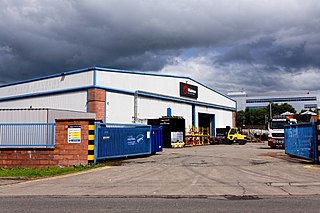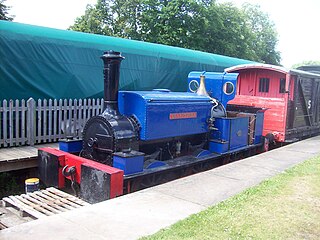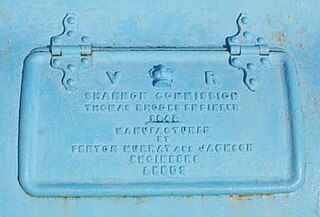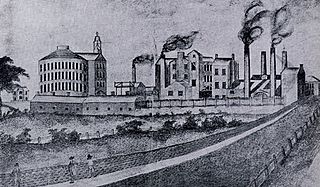Related Research Articles

Under the Whyte notation for the classification of steam locomotives, 0-4-0 represents one of the simplest possible types, that with two axles and four coupled wheels, all of which are driven. The wheels on the earliest four-coupled locomotives were connected by a single gear wheel, but from 1825 the wheels were usually connected with coupling rods to form a single driven set.

The Hunslet Engine Company is a locomotive-building company, founded in 1864 in Hunslet, England. It manufactured steam locomotives for over 100 years and currently manufactures diesel shunting locomotives. The company is part of Ed Murray & Sons.
Tulk and Ley was a 19th-century iron mining company in west Cumberland which also ran an engineering works at Lowca near Whitehaven.

Andrew Barclay Sons & Co., currently operating as Brodie Engineering, is a builder of steam and later fireless and diesel locomotives. The company's history dates to foundation of an engineering workshop in 1840 in Kilmarnock, Scotland.
Stoke railway works was set up in 1864 by the North Staffordshire Railway in the city of Stoke-on-Trent in the county of Staffordshire, England.

Hudswell, Clarke and Company Limited was an engineering and locomotive building company in Jack Lane, Hunslet, Leeds, West Yorkshire, England.
Kitson and Company was a locomotive manufacturer based in Hunslet, Leeds, West Yorkshire, England.

Manning Wardle was a steam locomotive manufacturer based in Hunslet, Leeds, West Yorkshire, England.

Nasmyth, Gaskell and Company, originally called The Bridgewater Foundry, specialised in the production of heavy machine tools and locomotives. It was located in Patricroft, in Salford England, close to the Liverpool and Manchester Railway, the Bridgewater Canal and the Manchester Ship Canal. The company was founded in 1836 and dissolved in 1940.

Fenton, Murray and Jackson was an engineering company at the Round Foundry off Water Lane in Holbeck, Leeds, West Yorkshire, England.
The Railway Foundry, Leeds, was a railway engineering workshop off Pearson Street, in Hunslet, Leeds, West Yorkshire, England. It was established in 1838 by Shepherd and Todd. Charles Todd had been a partner in Todd, Kitson & Laird but left to set up his own business in 1838, setting up the Railway Foundry with a Mr. Shepherd to build locomotives and rolling stock.

E. B. Wilson and Company was a locomotive manufacturing company at the Railway Foundry in Hunslet, Leeds, West Yorkshire, England.

Neilson and Company was a locomotive manufacturer in Glasgow, Scotland.
The Royal Ordnance Factory, ROF Patricroft, was an engineering factory was classified as a Medium Machine Shop. It was located in Patricroft, near the town of Eccles, in the City of Salford, Greater Manchester, England, adjacent to both the Liverpool & Manchester Railway and the Bridgewater Canal.

The Round Foundry is a former engineering works off Water Lane in Holbeck, Leeds, West Yorkshire, England. Founded in the late 18th century, the building was developed into the Round Foundry Media Centre in 2005.
Patricroft is a suburb near Eccles, Greater Manchester, England.

J&H McLaren was a British engineering company in Hunslet, Leeds, England, that manufactured traction engines, stationary engines and later, diesel engines.

John Chester Craven was an English locomotive engineer. He was the locomotive, carriage and wagon superintendent of the London, Brighton and South Coast Railway from 1847 until his resignation in 1870. He died in 1887.
An industrial steam locomotive is a type of steam locomotive which primarily ran on industrial railways to serve a company by transporting or assisting the manufacturing products of that particular company's produce. Industrial railways often transported items such as coal, iron, slate and workers to aid production. In many countries, industrial steam serving coal mines in particular, lasted significantly longer than the nations otherwise mainline steam traction, due to the readily available fuel.
References
- 1 2 Atkins 1999, p. 22.
- ↑ "Crook and Dean - Graces Guide".
- ↑ Dan Quine (2013). The George England locomotives of the Ffestiniog Railway. Flexiscale.
- Atkins, Philip (1999). The Golden Age of Steam Locomotive Building. Atlantic Transport Publishers. ISBN 0-906899-87-7.
- Lowe, J.W., (1989) British Steam Locomotive Builders, Guild Publishing